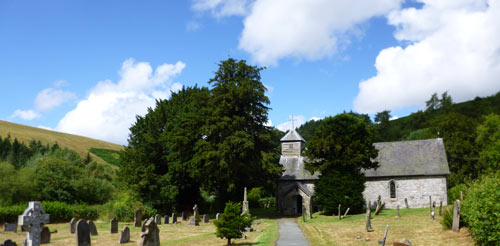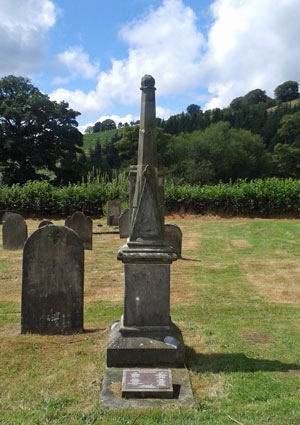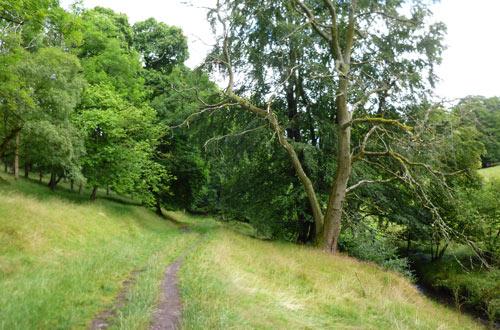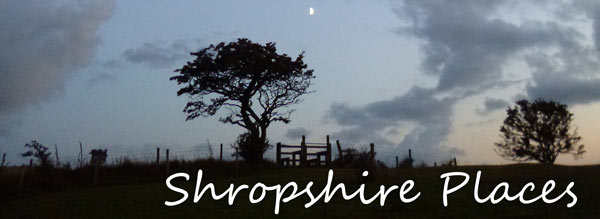Ratlinghope (also known as ‘Ratchup’) is a rural parish in Shropshire on the western side of the Long Mynd. The buildings making up the district are scattered over a mile or more, and there isn’t a traditional village centre. The parish church, St Margaret’s, is in a peaceful green valley by a river, neighboured by farm buildings. The old Manor and its farm are a short distance along a country lane. Half a mile away by road are Ratlinghope’s most popular destinations, the Horseshoe Inn and Ratlinghope Youth Hostel.

The Bridges pub
Generally known as ‘Bridges’, The Horseshoe Inn is a traditional country pub by the River Onny. Once there were several bridges here (a couple remain) and these gave the name to the spot. The pub has outdoor tables by the stream, where children love to paddle, as well as an attractive interior, more towards eating than drinking. The pub is a local landmark and popular with walkers, and travellers who come some distance for a meal or a drink.
Today the Horseshoe Inn is owned by the Three Tuns Brewery of nearby Bishop’s Castle. Full meals from a varied menu are served in the evening, and lighter meals are available at other times (ringing ahead to book is always a good idea). The menu offers vegetarian options as well as meat from a local farm, and traditional puddings. The chance to eat local produce and drink real ales from nearby Bishop’s Castle makes this a pleasingly ethical place to eat. The pub organises occasional events including a summer fun day and a music festival, and there are also B&B rooms.
Ratlinghope accommodation and events
Despite being buried in the green depths of the countryside, far from the modern world and mobile phone signals, Ratlinghope is the setting for more than one music event. Farmer Phil’s Festival, at Near Gatten Farm, is a longstanding music festival with camping in the hills close to Bridges.
Close to the pub at Bridges is the local youth hostel, YHA Bridges. Fairly spartan, this is a practical place to stay for walkers and holidaymakers exploring the area around the Long Mynd and the Stiperstones (there’s not much accommodation in this stretch of countryside.) More rugged travellers may prefer to camp at Brow Farm Campsite near Ratlinghope church.

Around Ratlinghope
The road which passes the youth hostel continues to Ratlinghope church, but walkers will find a better alternative; a lovely walk through woodland along the river (look out for the footpath sign on the left of the road.) This path divides with one branch heading out to the road by the old Manor House and another continuing to the church. A short drive (or attractive hilltop walk) south of Ratlinghope is the village of Wentnor, where travellers will find another great village pub. The nearest shop to Ratlinghope is a small general store off the main road near Wentnor. Church Stretton, on the other side of the Long Mynd, is the nearest town, and railway station.
Ratlinghope’s church of St Margaret is small and sweet. One of the building’s most interesting features is a 17th-century carved inscription on its wooden door. The church has stained-glass windows dating to the beginning of the twentieth century. An informative leaflet about the church and district is available in the church for a donation.
In the graveyard, to the left of the path, are the tombs of two notable local figures. A tall memorial commemorates Richard Munslow (1833-1906), said to be the last sin-eater in the county of Shropshire. A sin-eater, generally an impoverished unfortunate, would be asked to a funeral. In a ritual consumption of bread and ale, the sin-eater would take upon himself the sins of the deceased, meaning the dead could proceed to a quiet afterlife. Sin-eating had generally died out by Munslow’s time, and as a reasonably well-to-do farmer, he may have revived the practice for religious reasons. The author Mary Webb incorporated sin-eating into her novels set in the area. She spent time in Ratlinghope and may have known Munslow.
Also buried in the Ratlinghope churchyard is Mahlah Addyes Scott, a local benefactress who had the church restored in 1905. An interesting character, she came from a humble background and through marriage became lady of the manor. She built village schools in Ratlinghope and Norbury to educate local children (the Ratlinghope school is now the YHA building; the Norbury school is still open).

Walking from Ratlinghope
In the middle of the Shropshire Hills AONB and between the Long Mynd and Stiperstones, Ratlinghope is an excellent base for walking. It’s possible to follow footpaths up onto either of those ridges, or to explore the networks of paths in the green farmland and gentler hills between the two ridges. As described above, a pretty riverside footpath links the road near Bridges with Ratlinghope church, with a branch leading out onto the road near the old Manor House. From this riverside path a route leads on up the Darnford Brook – a looping circuit combining the Darnford Valley and a stretch of the Portway, an ancient drovers’ road, is described on a free walk leaflet available locally.
A narrow road from Ratlinghope, branching off between the Manor and the church, heads straight up between fields to the Long Mynd. Part of the way up, a footpath branches off to the left, skirting a couple of fields and a cottage to lead up onto the moorland. The clearly-defined track, with good views back over the Ratlinghope valley and hills, heads through the heather and rejoins the road on top of the ridge. From here there are paths leading down to Carding Mill Valley and Church Stretton, or up to Pole Bank, the highest point on the Long Mynd, and onwards along the ridge.
From Bridges there is a good walk up onto Adstone hill, following this green ridge – with wonderful views – along to the village of Wentnor, or crossing to the Long Mynd via Priory Cottage. The ‘Adstone Walk’ is another circuit described on local leaflets, along with other directions for short walks around Wentnor and Ratlinghope.
The Stiperstones is further away but can still be reached on foot – although for the best walking experience it’s probably more effective to drive up to the Stiperstones car park and plan a circular walk from there, as there is so much to see around the Stiperstones ridge.
Here are directions for a good 8-mile circular walk from Bridges: Bridges – Ratlinghope – Long Mynd – Wentnor -Adstone Hill.

Transport
Ratlinghope does not have year-round public transport. It is, however, on the route of the Shropshire Hills Shuttle Bus service which operates on weekends and bank holidays between April and September. This helpful service makes it possible to reach Ratlinghope from Church Stretton railway station without needing a car or taxi, and it gives additional scope to walkers planning day walks. Season, day rover and single tickets are available, and the buses are free for holders of concessionary passes. There’s a bus stop close to the pub at Bridges, and at the time of writing the bus also stops when hailed (providing this is on a safe stretch of road).
If driving to Ratlinghope, be aware the routes over the Long Mynd from Church Stretton are narrow exposed roads with few passing places, and can be perilous in bad winter weather. Roads connecting the village with Bishop’s Castle and Shrewsbury are more reliable and are generally a better option for access.
